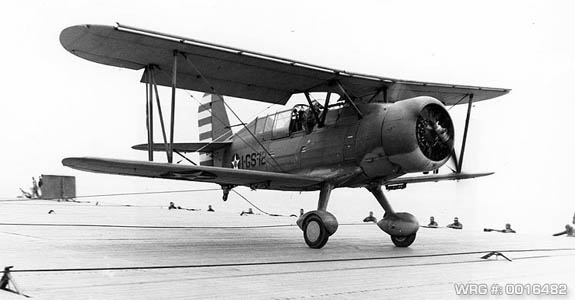U.S. NAVAL AVIATION RESOURCE CENTER > SEAPLANES > SEAGULL > PREVIOUS PAGE
CURTISS SOC SEAGULL
Operational History
The first ship the SOC was assigned to was the
USS Marblehead in November 1935; by the end of the decade, the SOC had replaced its predecessor throughout the fleet. Production came to an end in 1938. By 1941, most battleships had transitioned to the Vought OS2U Kingfisher and cruisers were expected to replace their aging SOCs with the third generation SO3C Seamew. The SO3C, however, suffered from a weak engine and plans to adopt it as a replacement were scrapped. The SOC, despite being a craft from an earlier generation, went on to credibly execute its missions of gunfire observation and limited range scouting missions.
Through the first six months of naval service, the SOC was known as the XO3C-1, The designation was changed to SOC when it was decided to merge its scouting and observation roles. The SOC was not called the Seagull until 1941, when the U.S. Navy began the wholesale adoption of popular names for aircraft in addition to their alpha-numeric designations. The name Seagull had earlier been given to two civil Curtiss aircraft, a Curtiss Model 18 and a Model 25, both converted Curtiss MF flying boats.
When operating as a seaplane, returning SOCs would land on the relatively smooth ocean surface created on the sheltered side of the vessel as it made a wide turn, after which the aircraft would be winched back onto the deck.

U.S. Navy Lieutenant Commander Lex L. Black, commanding officer of observation squadron VGS-1, makes 2000th landing on the escort carrier USS Long Island (AVG-1), 20 April 1942. He was flying a Curtiss SOC-3A Seagull. Note lowered flaps and deployed leading edge slats on the upper wing.
[Source: U.S. Navy Photo]
When the SOC had been replaced by the
OS2U Kingfisher, most remaining airframes were converted into trainers, and were used until 1945. But in a strange twist of history, with the failure of the
Curtiss SO3C Seamew, many SOCs in second line service were returned to front line units starting in late 1943 and saw service aboard warships in the combat zone for the rest of World War II. This is one of the few instances in aviation history of an older aircraft type that was retired or sent to second line service, replacing the new aircraft type, that was supposed to replace it!
Sources:
Wikipedia
U.S. NAVAL AVIATION RESOURCE CENTER > SEAPLANES > SEAGULL > PREVIOUS PAGE

